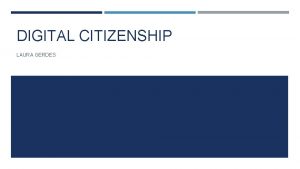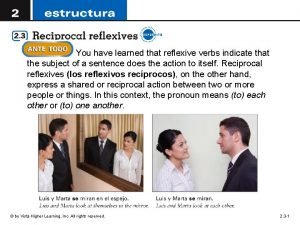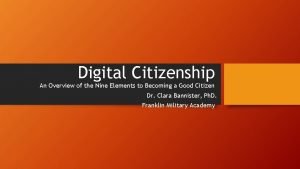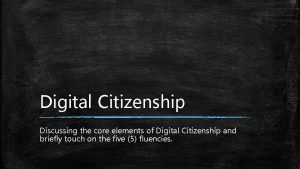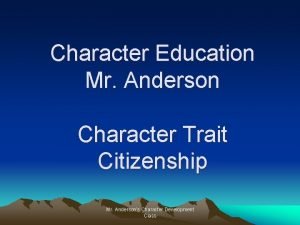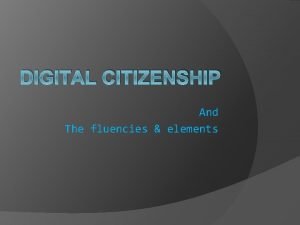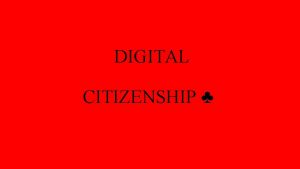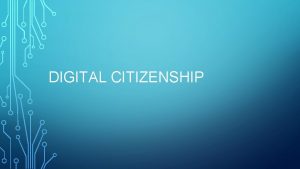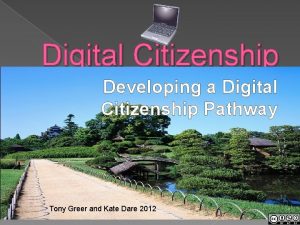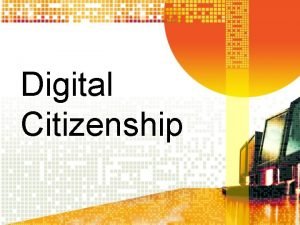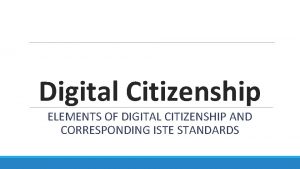DIGITAL CITIZENSHIP LAURA GERDES WHAT IS DIGITAL CITIZENSHIP








- Slides: 8

DIGITAL CITIZENSHIP LAURA GERDES

WHAT IS DIGITAL CITIZENSHIP? “Digital citizenship is the ability to think critically, behave safely, and participate responsibly in the digital world. ” - Common Sense Education “The Art of Social Media” CC by 2. 0 by Mkhmarketing

DIGITAL CITIZENSHIP INTRODUCTION VIDEO Rings of Responsibility Presented by Common Sense Media

WHY DO STUDENTS NEED TO LEARN ABOUT DIGITAL CITIZENSHIP? Internet safety and privacy Find credible sources Copyright and fair use Prevent cyberbullying Digital footprint awareness ”Cyber Security Lock” CC by 2. 0 by typographyimages

STUDENT ACTIVITY After exploring Digital Citizenship scenarios on Digital. Compass. com, groups of 3 -4 (7 th grade) students will use the Book. Creator app to write and illustrate a 8 page guide (introduction, 6 tips, conclusion) on one of the following topics: How to prevent cyberbullying How to find credible sources How to cite and credit sources How to stay safe online ”Writing” CC by 2. 0 by dotmatchbox How to maintain privacy online

LEARNING STANDARDS TEKS Middle School Technology 5 C – The student can practice safe and appropriate online behavior, personal security guidelines, digital identity, digital etiquette, and acceptable use of technology. 5 D – The student understands the negative impact of inappropriate technology use, including online bullying and harassment, hacking, intentional virus setting, invasion of privacy, and piracy such as software, music, video, and other media.

ASSESSMENT RUBRIC 3 2 1 Content Project includes an introduction, conclusion, and 6 relevant tips related to the topic. Project includes most of the required elements. Not all tips are relevant. Project is missing many key elements. Collaboration and Participation All group members added meaningful ideas and aided in the creation of the book. Most group members added meaningful ideas and aided in the creation of the book. Several members did not participate. Visuals All tip pages include appealing visuals related to the content. Some tip pages include Many tip pages are appealing visuals related missing visuals related to to the content. Conventions Accurate spelling and grammar present throughout the project. Some spelling and grammatical errors throughout the project. Many spelling and grammatical errors throughout the project.

RESOURCE LIST Dotterer, G. , Hedges, A. , & Parker, H. (2016). Fostering digital citizenship in the classroom. The Education Digest, 82(3), 58 -63. Harris, B. (2018, February 5). 4 Great lesson plans for internet safety [Web log post]. Retrieved from https: //www. commonsense. org/education/blog/4 -great-lesson-plans-for-internet-safety Ribble, M. (2012). Digital citizenship for educational change. Kappa Delta Pi Record, 48(4), 148 -151.
